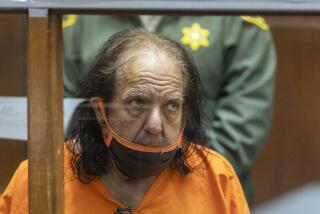Celebrity lawyers Shapiro and Geragos at odds over sex tape in actor’s rape case

The rape accounts sounded strikingly similar.
Two women, who didn’t know each other, told authorities about separate incidents in which they had accompanied actor Robert Aaron Stephens on a night out in Hollywood. They both accepted a drink from him and quickly felt dazed after drinking it. Each woman testified that they were later sexually assaulted at his apartment.
Prosecutors accused Stephens of giving the women drinks with the “date rape” drug GHB. In 2013, after a jury found him guilty of rape and other charges, he was facing a life sentence in prison.
But newly disclosed evidence recently prompted a judge to throw out the rape and assault convictions tied to one of the women and order a new trial after finding that Stephens’ trial attorney was “ineffective.” Now, a new lawyer for Stephens, 36, is challenging the remaining guilty verdicts.
The case has pitted against each other two heavyweights in the world of celebrity lawyers.
On one side is Robert Shapiro, the 72-year-old high-powered attorney who assembled O.J. Simpson’s legal “dream team” and represented Stephens at his trial.
On the other is Mark Geragos — known for representing such celebrities as Winona Ryder, Michael Jackson and Chris Brown — who now counts Stephens as a client and has accused Shapiro of failing to provide him effective legal counsel.
At the center of the case is Shapiro’s decision not to show jurors a video that Geragos says contradicts the testimony of one of Stephens’ accusers. The video, secretly recorded by Stephens, shows him and the woman engaging in consensual sex, Geragos argued.
After viewing the video, Los Angeles County Superior Court Judge Craig J. Mitchell agreed, saying in a January ruling that the recording clearly shows Stephens and one of the women, and refutes her testimony “to such an extent that this court cannot understand why the video was not used,” according to a court transcript.
“The court concludes that a significant portion of the nearly hourlong video appears to be inconsistent with a forcible sexual assault,” the judge said.
Mitchell granted a new trial on the charges involving the woman in the video but rejected Stephens’ request to order a new trial on the remaining counts of rape by use of drugs and assault with a deadly weapon connected to the second woman. Geragos has now set his sights on persuading the judge to undo the convictions in those counts too.
In an email to The Times, Shapiro said he and his legal team — including jury consultant Jo-Ellan Dimitrius, who worked on the Simpson case — had conducted “a great deal of research and thought” and concluded that showing the video “to a jury would be considerably more harmful than helpful.”
“The consensus was that when the alleged victim was carried into the bedroom, she looked dead,” Shapiro said in the statement.
Had he shown jurors the video and Stephens been convicted, the argument would have been made that he shouldn’t have used the recording, Shapiro said.
The Los Angeles County district attorney’s office declined to comment on the case.
Before his arrest, Stephens acted in about a dozen mostly uncredited television and film roles, according to the online movie database IMDB. He also was a lead actor in a 2007 horror film in which his character rapes and murders a woman at a party while recording the attack on a hidden camera.
Prosecutors filed charges against Stephens in 2011, alleging he sexually assaulted the two women in separate incidents more than a year apart.
One of the women accused Stephens of drugging her in his apartment in May 2009, court documents show. She told police that she woke up in Stephens’ bed, wearing his clothes, with no memory of that night. Next to her were clumps of her hair, she said. She told authorities Stephens grabbed her by the neck and choked her as she tried to leave.
A detective testified at a preliminary hearing that she arranged for the woman to phone Stephens, who confirmed during the conversation that the pair had engaged in sex but insisted that it was consensual. He also confirmed that he had GHB, but said he did not give it to the woman, the detective testified.
Police searched Stephens’ home and found GHB on his nightstand, the detective said in court.
At trial, the prosecutor told jurors that the woman had bruises and other injuries consistent with being raped while unconscious.
The second woman testified that she felt “weird” after drinking a chocolate martini prepared by Stephens at his apartment in October 2010. She said he threw her onto his bed and she tried to fight him off as he forced himself on her. She was left with scratches on her wrists, a lump on her head and a bruised lip, she said.
Stephens hired Shapiro, who was already well-regarded in legal circles before defending Simpson in 1995 but saw his fame skyrocket after the acquittal in the most-watched trial in history. Shapiro is also a co-founder and the public face of LegalZoom, one of the largest online providers of legal documents and filing services.
Stephens told Shapiro he surreptitiously made the video “so that he could protect himself from allegations of rape,” the attorney said in an affidavit filed in court.
In the affidavit, Shapiro said he believed the video would do more harm than good for Stephens’ defense. The video, he said, showed the woman in the 2010 incident appearing “limp and dead” when she was carried into the bedroom and she seemed to go in and out of consciousness, which could have led jurors to believe she was unable to give consent.
At times, the woman appeared to fight Stephens off, which would have corroborated her testimony, he said in the document. The fact that he secretly taped the encounter would have damaged his credibility with jurors and subjected him to the risk of additional criminal charges, Shapiro argued. Secretly recording someone undressing or having sex in a place where they expect privacy is a misdemeanor.
Shapiro said in the affidavit that he would have turned the recording over to prosecutors had he believed the video exonerated Stephens of the serious felony charges against him.
“The most difficult thing a lawyer in trial has to do is make strategic decisions,” Shapiro said in an interview. “Hindsight is always 20/20.”
A finding of ineffective assistance of counsel is rare, but can be damaging to an attorney’s reputation, legal experts said.
Geragos said he had never known an attorney to allow potentially exonerating evidence to go unused.
“I was astonished,” Geragos said. “I didn’t understand, and I still don’t understand it.”
The judge denied Stephens’ request for a new trial on all the counts he was convicted of, saying he found that the woman’s testimony about the 2009 incident was “incredibly persuasive and was additionally supported by physical evidence.”
Geragos said he plans to file a motion seeking a new trial on the remaining charges, saying the two separate allegations were inextricably intertwined by the prosecution. The prosecution, he noted, argued during the trial that the women’s combined testimony proved Stephens was a serial rapist who followed a similar pattern of behavior.
Shapiro said the ruling does not tarnish his legal career spanning more than 45 years.
“This was a judgment call that a judge disagreed with,” he said. “My reputation speaks for itself.”
More to Read
Start your day right
Sign up for Essential California for news, features and recommendations from the L.A. Times and beyond in your inbox six days a week.
You may occasionally receive promotional content from the Los Angeles Times.







